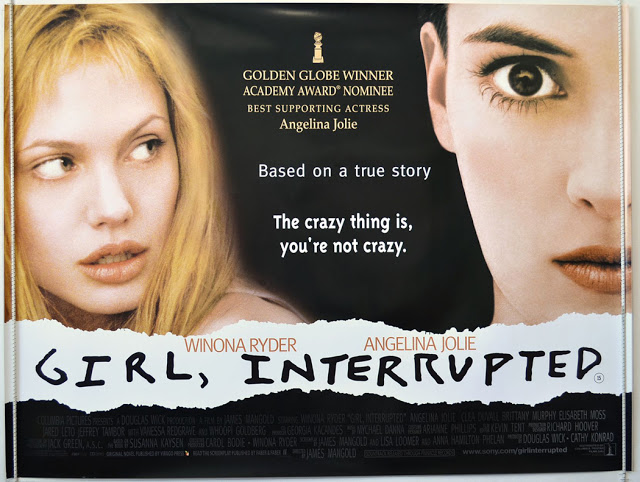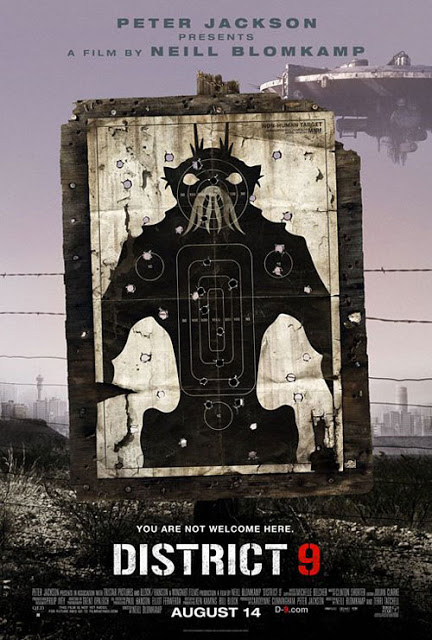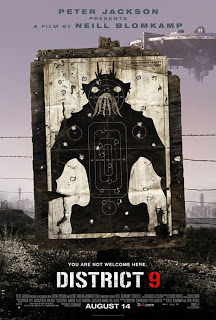 |
| Movie poster for Girl, Interrupted |
At first glance, Girl, Interrupted appears to be Hollywood’s version of feminist nirvana. It’s a veritable oasis in an industry where only 23% of speaking roles belong to women, an industry that tends to only depict women as supporting characters for the ever-important leading men. This 1999 film adaptation of Susanna Kaysen’s memoir of the same title features a strong core cast of women, some of whom went on to bigger stardom in the aftermath of the commercial success of the film.
Set to the backdrop of the late 1960s, Girl, Interrupted chronicles a fictionalized Susanna’s (Winona Ryder) year-long stint in the woman’s ward at Claymore, a private mental institution, after her attempted suicide and subsequent “break” with reality. Susanna is diagnosed with borderline personality disorder, a diagnosis she reluctantly accepts and from which she eventually “recovers.” Throughout the year, Susanna comes face-to-face with the “real” crazies in the form of sociopathic Lisa (Angelia Jolie), pathologically lying Georgina (Clea DuVall), schizophrenic Polly (Elizabeth Moss), and cocktail-of-issues Daisy (Brittany Murphy) who grapples with eating disorders, OCD, and a history of sexual abuse. The film suggests, sometimes overtly, that Susanna, by comparison to her ward-mates, isn’t doing so badly. In fact, Nurse Valerie (Whoopi Goldberg), in one of the most emotionally resonant scenes of the film, declares Susanna is “not crazy” but instead “a lazy, self-indulgent little girl who is driving herself crazy.” At this point, viewers are likely nodding their heads. Certainly, we’ve all met that girl. Or maybe we are that girl.
 |
| Winona Ryder as Susanna Kaysen in Girl, Interrupted |
Well, yes and no.
At its core, Girl, Interrupted strives to be a feminist film. However, I find the film’s representations of “mad women” problematic, particularly the ways in which mental illness becomes so closely linked with eroticized otherness. And here is where the film’s deep ambivalence comes into play: it attempts to dispel the myth of what it means to be a mentally ill woman, while at the same time reinforcing cultural stereotypes that portray mentally ill women as hypersexual, dangerous, amoral, or inherently unfeminine. In the end, Girl, Interrupted posits mental illness as a choice from which one, like Dorothy from the Wizard of Oz, can always return.
As Susanna checks into Claymore, she catches a glimpse of her doctor’s case notes that indicate her “promiscuous” tendencies as one symptom of her ailment. Yes, she had an affair with a married man, and, yes, she slept with the brother of one of her classmates; she loves neither of these men. At one point Susanna notes, “What kind of sex isn’t casual?” Certainly, her disavowal of love as a necessary component of sex is a feminist gesture. In the free-loving 60s, that sweeping diagnosis—promiscuity—encompassed nearly every rally, march, or peace protest in America, or at least modern-day viewers might suspect from the comfort of our viewing couches.
 |
| The women of Girl, Interrupted |
At several junctures, such as this one, Girl, Interrupted positions itself firmly as a feminist film, shattering assumptions that there exists one “proper” behavior for women. We sympathize with Susanna and with her plight against The Man, against a gendered, cultural understanding of what is and is not appropriate sexual behavior for a young woman. In many ways, her “illness” manifests itself in the typical American teenage coming-of-age way. Susanna asks herself questions we all have asked, at one time or another: Where do I fit in? Who am I? What do I value?
Throughout the film, Susanna’s character works to unravel stereotypes about what it means to be a woman with a mental illness: she’s beautiful; she’s smart; she’s never threatening. She’s much like any other young woman as we watch her negotiate friendships, write in her journal, sneak out at night with her friends, smoke cigarettes, and, generally, protest authority. In most ways, she’s an ordinary girl, just like you might find on the “outside.” The viewer begins to question if Susanna even really needs to be at Claymore in the first place.
 |
| Susanna Kaysen (Winona Ryder) and Nurse Valerie (Whoopi Goldberg) |
However, like many “crazy bitches” of cinema (Nina Sayers in Black Swan, Alex Forrest in Fatal Attraction) she exudes sexuality and charisma, deepened only by her sense of danger. As Susanna and Lisa spend time together, their growing friendship feels more like a courtship. Susanna herself can’t help but be drawn in by those pouty lips, her playfulness, her rabble rousing and bravado. At one point, as Susanna and Lisa are on the lam from Claymore, the two share a kiss. The moment is innocent enough, but the implications become clear. Lisa represents the eroticized other, the taboo, the forbidden, dark and amoral mad woman.
 |
| Angelina Jolie in her Oscar-winning role as Lisa in Girl, Interrupted |
 |
| Brittany Murphy as Daisy in Girl, Interrupted |
Here’s a statistic: nearly 1 in 5 Americans suffers from mental illness of some sort, and a majority of these cases are women. This alarming number becomes even more important when recognizing that the film industry plays an important role in shaping public or cultural perception. In light of this, I wonder how detrimental a film such as Girl, Interrupted might be when questioning the legitimacy of mental illness and perpetuating stereotypes of those who suffer from these invisible diseases. Susanna’s renewed commitment to get better situates itself as a choice, and not necessarily one between health and illness or between one treatment and another. Instead, Susanna’s choice is oddly contingent upon morality, what’s right and wrong. Will she choose to return to Claymore? Or will she tread the darker path, represented by the villainous Lisa?
Which brings us back to Nurse Valerie’s diagnoses that Susanna is “not crazy” but, instead, “a lazy, self-indulgent little girl who is driving herself crazy.” The idea that Susanna is not really sick—that her invisible illness is a complete manifestation of her imagination or her culture—may be true. But it may be equally true that she, and young girls like her, are not just lazy and self-indulgent. That no amount of “trying harder” or “choosing to be well” necessarily helps, without the proper intervention. The movie wants to suggest that, yes, Susanna is a little confused, uncertain, depressed, even, but at least she doesn’t burn her face, or hide chicken bones under her bed, or require the padded room for her outbursts. At least she’s not crazy-crazy. Not like “them.” Girl, Interrupted paints a world where mental illness is not an invisible illness. Invisibility means conformity means health, and only when one adapts more culturally-sanctioned “moral” or “feminine” behavior will she be considered well again.
 |
| Susanna (Winona Ryder) and Lisa (Angelina Jolie) share a kiss |
Susanna’s heroism, however, comes distinctly from her choice to overcome her diagnosis. To be fair, in real life, choice does play a legitimate aspect in the treatment of diseases. One can choose to be in treatment, or not to be. However, Susanna doesn’t simply learn to live with her personality disorder, she defeats it entirely. Toward the end of the film, the TV in Claymore’s living room flashes a scene from The Wizard of Oz as Glenda the Good Witch says, “You’ve always had the power to go back home.” Here, the film’s message reveals itself clearly: the power of recovery has always been with Susanna.
 |
| Angelina Jolie and Winona Ryder in Girl, Interrupted |
Viewers should be happy for Susanna, and I think most root for her. I know I do. But even as she’s being driven away from Claymore in the final scene, I wonder if she, herself, downplays the magnitude of the year she’s just spent under professional care. Perhaps she’s doing this because in the “outside” world, it’s still not okay to talk about such things or to admit to a mental illness without suffering stigmatization, or sideway glances, or nervous, sympathetic looks.
 |
| Lisa (Angelina Jolie) confronts Susanna (Winona Ryder) on her first day at Claymore |




